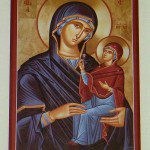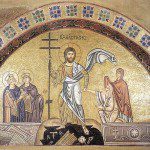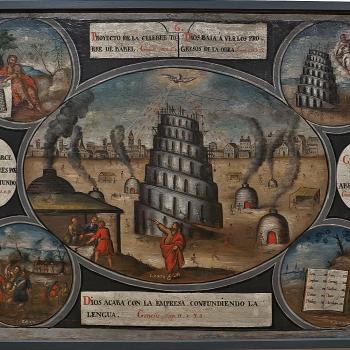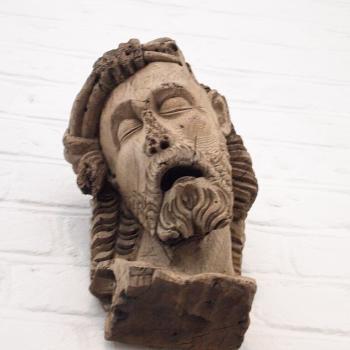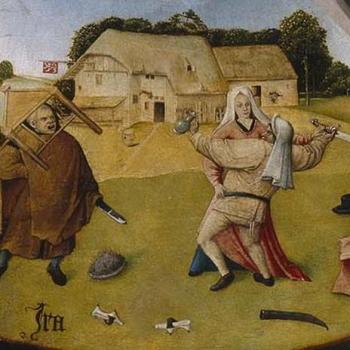Behold, Jesus on the cross. Behold him, the author of life, indeed, he who is life itself, on the cross. “In him was life, and the life was the light of men” (John 1:4 RSV). The light shines in the darkness, the light of life, Jesus, shines brightly on the cross, drawing us unto him, to look upon him and see: life is suffering.
![By St. John of the Cross [Public domain], via Wikimedia Commons](https://wp-media.patheos.com/blogs/sites/637/2016/03/John_of_the_Cross_crucifixion_sketch-e1458507131159-300x251.jpg)
The issue here is not simply the physical death that takes place thousands of time a day on earth. Rather, it is the death of the One who said of himself, “I am the life” (Jn 14:6; I:4; II2:25). What he meant by this expression of his being was not merely a transitory earthly life but life itself, eternal life, life in its purest essence. The One who is learning obedience does not simply have life like others around him – he is Life itself. Now one can begin to grasp what is demanded of him. For Life itself death cannot simply be something to be endured as every limited and transitory creature endures it as a part of its nature; rather, it must be a perishing proportional to Life uniquely itself. [1]
Life is suffering. He who is life has affirmed the suffering contained in life. Out of loving compassion, he made such suffering his own. He came to live out the human experience, a life of suffering. He dies with and through that same suffering, taking all the suffering of life and bringing it together unto himself as he is nailed upon the cross. He knew it was his mission, and so he preached the suffering he would have, both from the hands of others and then with the death on the cross: “And he began to teach them that the Son of man must suffer many things, and be rejected by the elders and the chief priests and the scribes, and be killed, and after three days rise again” (Mk 8:31 RSV).
Behold once again Jesus on the cross.
![Philippe de Champaigne [Public domain], via Wikimedia Commons](https://wp-media.patheos.com/blogs/sites/637/2016/03/1200px-Champaigne_La_Crucifixion-300x225.jpg)
And so, for our salvation He suffered with a most generalized suffering, not only with respect to His human nature but also in accordance with all the major members of His body. And although He could not experience any suffering with respect to His divine nature, He suffered with respect to every power of His soul – [suffered] with most acute suffering. For not only did He feel pain insofar as He suffered because of His wounds, but also He felt empathetic pain insofar as He suffered empathetically because of our wrongdoings.[2]
Jesus, life itself, suffered on the cross, revealing to all a divine truth: life is suffering. He suffered and died for all, sharing in the suffering and death of us all, uniting all of life’s suffering to himself:
But we see Jesus, who for a little while was made lower than the angels, crowned with glory and honor because of the suffering of death, so that by the grace of God he might taste death for every one. For it was fitting that he, for whom and by whom all things exist, in bringing many sons to glory, should make the pioneer of their salvation perfect through suffering (Heb. 2:9-10 RSV).
He is the true exemplar of life. He has revealed the suffering of life by taking on the suffering of our lives and making it one with himself. Thus, as Bl. Henry Suso declared, “Who does not suffer on earth? No one.” [3] No one, indeed, not even Jesus, because he chose to join in the human condition and make it his. By becoming man, the Son of God, the author of life, assumes the suffering of life itself and in doing so reveals the universal truth that life truly is suffering. Though we can and do have all kinds of pleasures and joys in life, they are transitory. They do not satisfy. We must face the truth. Life does not provide any permanent form of happiness through earthly pleasures. We are always desiring more, seeking out more, and finding what we have is unsatisfactory. And life has an end; we will die, and that death which lies before us reveals the suffering which pervades us throughout our life:
Man lives with one eye on death. The fact that he does not know when it will come makes no difference. He cannot live as if this hour does not concern him, as if it does not strike for him, or as if it is so much in God’s power (since strike it must) that man can go on oblivious without it. On the contrary: he must live with a view to this hour; he must keep it insight, he must let it have the meaning God has given it right from the very beginning: the meaning of punishment.[4]
Life is suffering, for its ultimate fate, death, reveals the ultimate destiny of our life. It is death, and with death comes the suffering of death. And yet it is not just the death, the end, which determines that life is suffering, it is all the conditions which allow for and lead to our death which make it suffering. That is, the general frailty of life shows that life is not something which can last, a frailty which opens up to all kinds of weaknesses in which various forms of suffering can occur.[5] We cannot hold on to life itself without external help, and when we fail to get it, we suffer. Likewise, we have to rely upon the environmental conditions in which we find ourselves in for life – and we find that if it is too hot or too cold, we suffer if not die because of it.
Thus, life is suffering, and if we contemplated more the kind of suffering we experience, we could find many ways to express it, such as we find delineated by Asaṅga:
And the divisions of suffering are of eight kinds: [1] suffering of birth, [2] of aging, [3]of disease, [4] of death, [5] suffering of association with what is unpleasant, [6] suffering of separation from what is pleasant, [7] suffering if one does not obtain what one desires, and [8] in brief, the five aggregates of attachment are suffering.[6]
Life is suffering, and he who is life himself, in and through the cross, has taken upon himself all the suffering of life. He bore all such suffering to reveal his compassionate solidarity with us in our suffering. He suffered the general suffering of human existence (birth, ageing, death). He also experienced the particular suffering of not obtaining his human desire as expressed in the Garden of Gethsemane: “My Father, if it be possible, let this cup pass from me; nevertheless, not as I will, but as thou wilt” (Matt. 26:39 RSV). Likewise, he suffered in the way of having the good and pleasant things of life taken from him, as well as being given what was unpleasant in and through his treatment on the cross. In and through his humanity and his human will, he suffered all that he could suffer, suffered through the general forms of suffering and the greatest form of suffering in and through his death and descent into hell.
Behold, then, Jesus suffering on the cross:
Then when the innocent Lamb, who is the true Sun of justice, had hung upon the cross for the space of three hours, and when the visible sun, out of compassion for its Maker, had hidden the rays of its light, now that all things were consummated, at the ninth hour that Fountain of Life dried up.[7]
Out of compassion, Jesus died for us, the purpose of which was to alleviate our suffering, for, as Buddhaghosa explained, one who is compassionate will not be able to stand to see the suffering of others and will do what he or she can to alleviate it:
Compassion is characterized as promoting the aspect of allaying suffering. Its function resides in not bearing others’ suffering. It is manifested as non-cruelty. Its proximate cause is to see helplessness in those overwhelmed by suffering. It succeeds when it makes cruelty subside and its fails when it produces sorrow.[8]
The all-compassionate one, therefore, took on suffering for us, affirming our suffering, acknowledging it, declaring it as he declared the basis for it: humanity, having forsaken God in sin, has found itself forsaken by God (cf. Matt 27:46). The human condition has, in a way, been forsaken by God, because it closed itself to the kingdom of God and God’s grace, making for what we have left of life to be riddled with suffering. He who is life itself comes, takes on the human condition, and suffers with us. “For our sake he made him to be sin who knew no sin, so that in him we might become the righteousness of God” (2Cor. 5:21 RSV). That is he who is life, who is also sinless and knew no sin, came in solidarity with us, and took on the effects of sin, that is, he suffered with us as if he sinned:
And what has He done? “Him that knew no sin He made to be sin, for you.” For had He achieved nothing but done only this, think how great a thing it were to give His Son for those that had outraged Him. But now He has both well achieved mighty things, and besides, has suffered Him that did no wrong to be punished for those who had done wrong. But he did not say this: but mentioned that which is far greater than this. What then is this? “Him that knew no sin,” he says, Him that was righteousness itself , “He made sin,” that is suffered as a sinner to be condemned, as one cursed to die.[9]
We find, therefore, not only is life suffering, we find that such suffering came about from a cause and that cause is in our sin. Life is put up on the cross and suffers for us, out of compassionate love for us, to help overcome the suffering we have made out of life. But to do so, he must and does show us the source of suffering, and he shows it is not from God but rather from us. He shows us how and why life is suffering and that it is suffering because of what we have done, that is, because of our iniquities, our sin:
Surely he has borne our griefs and carried our sorrows; yet we esteemed him stricken, smitten by God, and afflicted. But he was wounded for our transgressions, he was bruised for our iniquities; upon him was the chastisement that made us whole, and with his stripes we are healed. All we like sheep have gone astray; we have turned every one to his own way; and the LORD has laid on him the iniquity of us all (Isa. 53:4-6 RSV).
Our wickedness, our defiled actions, have caused life to be suffering, and so he who is life itself comes to us and reveals the full extent of the suffering we have made for ourselves in and through his own suffering. He suffers to the height of suffering, experiences the whole of human suffering in his person, all because we have made the human condition one full of suffering. Life is suffering because we make it so. It is our fault. He comes and accepts the condition which we have created for life, takes it upon himself, and show us all what life has become because of our actions. But then he shows that in and through his death that despite all such suffering, despite all we have done, God really has not abandoned us. Life is suffering and yet, even in and through that suffering, God’s love remains for us, and in and through compassion, he does whatever is needed to make us understand that life is suffering because we have made it so:
For what we endured for our wicked deeds, he suffered for us, making peace through the blood of his cross, whether with things on earth or with things in heaven [cf. Col 1:20]. “For he himself is our peace, who made the two one and destroyed the middle wall of the enclosure, the enmity of the flesh” [Eph 2:14], and by his bruises we are healed. From this it is clear that, just as his scourged and mangled body bore the marks of his injuries in his welts and bruises, so too his soul truly suffered pain for us, lest we should believe partial truth and partial falsehood with respect to Christ.[10]
We have created our own suffering because we have turned away from the path to true happiness and instead pursued and attached ourselves to limited, transitory goods which offer momentary pleasure at best. When we find the pleasure is gone, what we have left is the suffering which comes in their wake. With such a loss, and no proper direction or understanding what we should do, we end up continuing to do that which has caused our suffering, time and time again, only making more and more suffering for ourselves. They combine and permeate our life and death, making it full of suffering. Thus, St Maximus explained, life is suffering because of our actions, because of what we pursue in and through our lives. God has left pain and sorrow as the outcome, not out of hate, but to help redirect us, to guide us away from those things which would hurt us more:
Because of the meaningless pleasure which invaded human nature, a purposive pain, in the form of multiple sufferings, also gained entrance. It is in and from these sufferings that death takes its origin. Such pain drives out unnatural pleasure, but does not totally destroy it. Its total destruction is effected by the grace of divine pleasure when this is active in the intellect.[11]
Death, therefore, has come into the world through our misdirected deeds, and has turned our life to a life of suffering. Death permeates the meaning and significance of all things in life, and as death is experienced in and through suffering, all things in life are touched by suffering.
Behold, again, Jesus on the cross.
![Albrecht Dürer [Public domain], via Wikimedia Commons](https://wp-media.patheos.com/blogs/sites/637/2016/03/Albrecht_D%C3%BCrer_-_The_Crucifixion_NGA_1943.3.3496-221x300.jpg)
[1] Hans Urs von Balthasar, You Have Words of Eternal Life. Scripture Meditations. trans. Dennis Martin (San Francisco: Ignatius Press, 1991), 147-8.
[2] Nicholas of Cusa, “Jesum Quaeritis” is Nicholas of Cusa’s Early Sermons: 1430- 1441. trans. Jasper Hopkins (Loveland, CO: The Arthur J. Banning Press, 2003), 256.
[3] B. Henry Suso, “Little Book of Letters” in Henry Suso: The Exemplar With Two German Sermons. trans. Frank Tobin (New York: Paulist Press, 1989), 336.
[4] Adrienne von Speyr, The Mystery of Death. trans. Graham Harrison (San Francisco: Ignatius Press, 1988), 8-9.
[5] “As to the frailty of life: this life is impotent and frail. For the life of beings is bound up with breathing, it is bound up with the postures, it is bound up with cold and heat, it is bound up with the primary elements, and it is bound up with nutrients,” Buddhaghosa, The Path of Purification. trans. Bhikkhu Ñāṇamoli (Onalaska, WA: Buddhist Publication Society, 1991), 231.
[6] Asaṅga, Abhidharmasamuccaya. trans. Walpola Rahula (Freemont, CA: Asian Humanities Press, 2001), 84. [transliteration from the Sanskrit in the text has been removed by me, for the ease of the reader]. The “five aggregates” are the components which come together to establish a human person, being : our material form, the feelings we experience associated with pleasure and pain and like feelings, cognition (mind or nous in Greek philosophical terms), volition/will, and the various forms of consciousness associated with the senses.
[7] St. Bonaventure, “The Tree of Life” in Bonaventure: The Soul’s Journey to God, the Tree of Life, The Life of St. Francis. trans. Ewert Cousins (New York: Paulist Press, 1978),153.
[8] Buddhaghosa, The Path of Purification, 310.
[9]St. John Chrysostom, “Homilies on Second Corinthians” in NPNF1(12): 334.
[10] St. Jerome, Commentary on Isaiah in St. Jerome- Origen. Commentary on Isaiah. trans. Thomas P. Scheck (New York: Newman Press, 2015), 668-9.
[11] St. Maximos the Confessor, “Fourth Century of Various Texts” in The Philokalia: The Complete Text. Volume Two. trans. G.E.H. Palmer, Philip Sherrard and Kallistos Ware (London: Faber and Faber, 1990), 244.
Stay in touch! Like A Little Bit of Nothing on Facebook:
A Little Bit of Nothing


